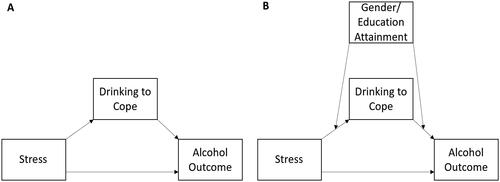Figures & data
Table 1. Participant demographics and mean AUDIT, DASS-Stress, and drinking to cope scores at the initial (T1), second (T2), third (T3), and fourth (T4) time points of the study.
Figure 1. (A) Drinking to cope mediating the stress and alcohol outcomes (alcohol consumption, alcohol dependence alcohol harms) relationship; (B) drinking to cope mediating the stress and alcohol outcomes relationship, with moderation by gender or education.

Table 2. Standardised Indirect effect (R2) of stress (measured at T1) on AUDIT-C subscales (measured at T1, T2, T3, and T4) as mediated by DMQ-a drinking to cope (measured at T1).
Table 3. Standardised Indirect effect (R2) of stress (measured at T1) on alcohol outcome (measured T4) as mediated by DMQ-a drinking to cope (measured at T4).
Table 4. Index of moderated mediation for the relationship between stress and AUDIT-C (measured at T1, T2, T3, T4) as mediated by DMQ-a drinking to cope and moderated by gender and education.
Table 5. Index of moderated mediation for gender (male or female) and education (tertiary qualification and no tertiary qualification) on the relationship between stress (measured at T1) and AUDIT-C (measured at T4) as mediated by DMQ-a drinking to cope (measured at T4).
